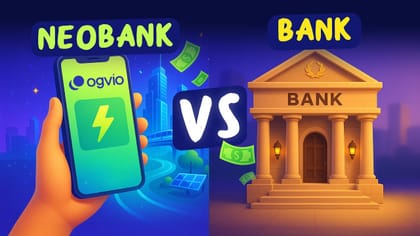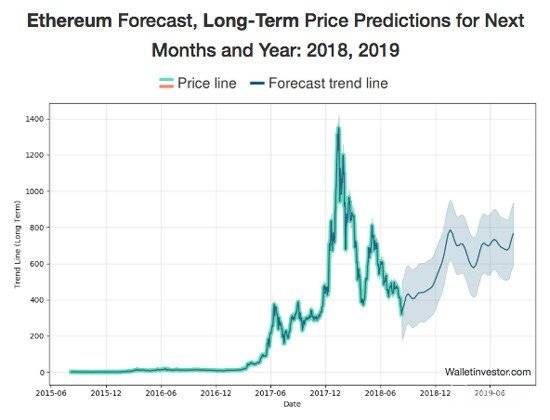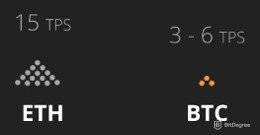Stop overpaying - start transferring money with Ogvio. Sign up, invite friends & grab Rewards now! 🎁
Are you currently an Ethereum investor and want to find out what the future holds? Or maybe you are thinking about making a purchase and want to know if now is a good time? Well, look no further as I am going to tell you everything you need to know about the future of Ethereum!
By the way, did you know that in 2017, the price of Ethereum went up by almost 10,000%? Crazy, right?!
Anyway, in this the future of the Ethereum guide, I am going to start by briefly explaining what the project actually is, followed by an overview of some of the issues that will affect its price.
After that, I am then going to discuss some of the potential solutions the Ethereum team is working on to fix their scalability problems. Finally, I will discuss some popular price predictions and give you my opinion on whether I think it’s a good investment.
So, what are you waiting for? Let’s start by making sure we know what Ethereum actually is!
(If you’re already confident with your knowledge on the background and concept of Ethereum, feel free to skip to the next section!)

Did you know?
Subscribe - We publish new crypto explainer videos every week!
What Is a Neobank (And Should You Use It)?


Table of Contents
A Brief Introduction to Ethereum
Ethereum was created in 2015 by lead-developer Vitalik Buterin and is now the second most valuable coin in the cryptocurrency industry.
It was the first blockchain project to install smart-contract technology, which allows people to enter into an agreement without needing a third party. It was also the first blockchain to include a programming language.

Ethereum can also host decentralized applications (dApps), which are apps that function without a central point of control, making them fair and transparent. One of the most successful dApps to be built on Ethereum is CryptoKitties, which is a platform that allows people to buy, sell and even bread virtual cats!
On top of this, Ethereum also has its own cryptocurrency which is called Ether. Just like Bitcoin, Ethereum allows you to send and receive coins between wallets. A transaction average about 16 seconds and the maximum amount the blockchain can process is 15 transactions every second.
Just like Bitcoin, the Ethereum blockchain uses a consensus mechanism called Proof-of-Work, however as I will explain later, they are looking to change this to something else due to scalability issues.
The Ethereum blockchain also allows its user to create new tokens, which are mainly called ERC-20 tokens.
So now that you know what the Ethereum project does, the next part of my future of the Ethereum guide is going to look at the platform’s scalability issues.
The Future of Ethereum
Although the Ethereum blockchain is the second most popular in the cryptocurrency industry, it actually has a few issues regarding scalability. (Scalability refers to the number of transactions a blockchain can process per second.)
As I mentioned earlier, Ethereum is only able to process 15 transactions per second. In the early days of the project, this was not a problem, as not many people were using it. However, as Ethereum has got more popular, it has become the biggest issue the Ethereum blockchain faces.
To give you an idea of how limited it is, the NEO blockchain (which can also process smart contracts) can reportedly process up to 10,000 transactions per second. Unless the Ethereum developers resolve their scalability issue, then organizations might consider using other blockchains to host their smart contracts and dApps instead of Ethereum. If this happens in the future of Ethereum, its price is likely to crash.
So, as you can see, this issue is of paramount importance.
Fortunately, the Ethereum developers are fully aware of these issues and they are in the process of making some significant changes. Let’s take a look at the possible solutions in more detail.
Proof-of-Stake (Casper)
Do you remember how I mentioned earlier that the Ethereum blockchain uses the Proof-of-Work consensus mechanism? Well, this is one of the reasons that has led to their technical problems. As a result, the team is considering switching over to Proof-of-Stake.
Proof-of-Work requires miners to use their extra computational power to solve really complex puzzles. Whoever has the most powerful hardware device has the greatest chance of winning the mining reward. Everyone tries to solve the puzzle at the same time, and the winner is the miner who solves it first.
Proof-of-Stake is different, as the miners do not all attempt to solve a puzzle at the same time. Instead, they work one by one. They are selected to mine at random, although, they must ‘stake’ a number of Ether in order to have a chance of being selected.
The number of transactions they can then mine/verify is determined by the amount they stake. If a miner stakes 10 ETH, they can mine 10 ETH’s worth of transactions. To clarify, this means they can mine until the worth of the transactions they have mined is equal to the amount they staked.
There are lots of benefits that Proof-of-Stake could bring to Ethereum. The first is increased energy efficiency. The Proof-of-Work network requires very large amounts of electricity, as all miners work on the same puzzles, wastefully burning away their computational power. On the other hand, Proof-of-Stake works on a one-by-one system, meaning much less overall electricity is used.
The future of Ethereum using Proof-of-Stake will also reduce the risks of centralization. Proof-of-Work allows groups of miners to join their resources to increase their chances of winning the mining reward. The problem with this is that it gives a small number of people lots of influence over the network, especially those that control large pools of miners. Proof-of-Stake, however, makes this very difficult to achieve.
The Ethereum developers call the movement from Proof-of-Work to Proof-of-Stake, the “Casper Project”, and it is being led by Vlad Zamfir.
Although the Casper upgrade was first discussed in mid-2017, the team is yet to finish working on it. It was believed that it will be installed during 2018.
So now that you know about the Casper project, the next part of my future of the Ethereum guide is going to look at their “Plasma” upgrade.
Plasma
The Plasma project was first announced by Vitalik Buterin in August 2017 and is being developed to solve Ethereum's scalability problems. Essentially, Plasma is a protocol that will allow the Ethereum blockchain to remove the need to process unnecessary data. It will do so by creating a second layer on top of the main blockchain.
It will still be able to process smart contracts, however, it will only post them to the blockchain once the contract has been completed. This will significantly reduce the amount of computational power the blockchain needs to confirm transactions and it will also save lots of memory.
The Plasma protocol will also speed up transaction times, which will allow the network to host dApps without slowing the system down.
Plasma development is still in its very early days of production, so we are not yet sure when it will be installed on top of the Ethereum blockchain.
The next part of my future of the Ethereum guide is going to look at another option that is also being considered by Ethereum.
Sharding
Just like in the case of the Plasma protocol, Sharding is also being developed to solve the issues of scalability. Before understanding what Sharding will do, let's try and understand what the actual issue is.
At the moment, every node that is connected to the Ethereum blockchain needs to verify every single transaction that goes through it. For example, if there are 4,000 transactions that need to be verified in the next block, then every node must verify all 4,000 transactions.
Although this is really good for security, it also means that the network is only as quick as the individual nodes that are connected.
Sharding will do things differently. Once it is installed, the network will be divided into smaller parts, with each part being called a shard. Every individual shard will hold different transaction histories, which each node can independently work on. It is hoped that this will significantly increase the number of transactions that the Ethereum blockchain can process, as it doesn't need every node to confirm every single transaction.
To make sure you understand sharding, think about a group of workers who are cleaning a house. In the current Ethereum blockchain, the group of workers would each individually clean every single room.
That means that every worker will need to clean the bathroom, kitchen, dining room and all the bedrooms. Is this efficient? Definitely not! With the sharding protocol, each worker would be given one room to clean, meaning that they would be able to finish their job significantly faster!
Vitalik Buterin has explained that the layer-one (Sharding) and layer-two (Plasma) solutions can be installed side-by-side. Buterin has also stated that Sharding alone could increase Ethereum's scalability limit by at least 100 times. Once you add in Plasma, Ethereum could be processing tens of thousands of transactions per second!
So, now that you know about Sharding and Plasma, the next part of my future of the Ethereum guide is going to look at what the Raiden project is!

- Secure and reliable
- Accepts fiat currencies
- Lots of trading options
- Reputable exchange
- Accepts fiat currencies
- Offers various trading options

- Huge trading variety
- Regulation-compliant around the globe
- Fair trading fees
- Beginner-friendly
- A wide array of features
- Vast number of different crypto coins & tokens

- Beginner-friendly
- Secure
- Decent trading and withdrawal fees
- Crypto.com Visa Card
- Automated tools & bots
- Ecosystem synergy with CRO
Raiden
The Raiden project (or Raiden Network) is being built by a third-party organization that is not a part of the Ethereum team. The idea centers on taking payment transactions "off-chain". This means that transactions do not need to be processed and confirmed by the entire blockchain.
Instead, only the two parties involved in the transaction need to reach consensus. Anybody who wants to enter into an agreement can open a new "channel" on top of the Ethereum protocol which can only be used by those involved in the transaction.
The only time that users need to go back "on-chain" is when they want to spend their tokens outside of the Raiden platform.
Interestingly, Vitalik Buterin has actually spoken negatively about the Raiden project, most specifically about their reasons for doing an ICO. Buterin questioned why they needed to create a token and raise funds. Nevertheless, Raiden raised over $33 million.
Now that you have a good understanding of the major project developments that could be installed on top of the Ethereum blockchain, the next part of my future of Ethereum news guide is going to look at some possible Ethereum future predictions.
The Future of the Price of Ethereum
It is important to let you know that if any of the above solutions are successfully implemented, the price of Ethereum is likely to increase.
The reason for this is that even though the network is only able to process 15 transactions per second, it is still the second most valuable cryptocurrency in the industry. Imagine how well the coin could do if it was able to increase this number to thousands of transactions per second?
Anyway, I wanted to discuss some Ethereum predictions that currently exist. The first popular Ethereum forecast I came across was by Gaurav Iyer of Profit Confidential. Iyer argues that Ethereum's scalability problems have restricted the price of Ethereum going forward. However, he believes that once it is resolved, the price of Ethereum could reach $1,500 in 2023.
The highest price that Ethereum has ever hit is $1,377, which it reached in January 2018. If Iyer’s Ethereum future predictions are correct, it will need to reach a new all-time high.
Another forecast I came across was by Investing Haven. The prediction service takes a slightly different approach, as they have used technical chart analysis based on previous supply and demand data.
Investing Haven says the Ethereum future price will reach $1000 by the year 2023. Although this is technically a positive prediction (as it is much higher than the price of June 2018), it is a very conservative one. The reason for this is that $1,000 would still not overtake Ethereum's all-time high from January 2018, meaning that they expect growth to be very slow.
In my third Ethereum forecast prediction, I looked at WalletInvestor, who believes that Ethereum will reach $1,221 by June 2023, which is just short of Ethereum's all-time high. Unfortunately, WalletInvestor does not give any explanation as to how they reached their prediction, which makes it difficult to analyze.

The final Ethereum price prediction I came across was by LongForecast, who has an interesting insight into 2023. According to their analysis team, Ethereum will begin 2023 as low as $363, however, it will slowly increase throughout the year, ending at $841.
It is frustrating that LongForecast does not explain why they believe that the price of Ethereum will start 2023 so low, nor why they think it will recover later in the year.
How do you see the Etherum future price going forward in 2023 and beyond? Do you agree with any of the above analysts? In the final part of the future of the Ethereum guide, I am going to give you my opinion on how I see the future.
My Opinion on the Future of Ethereum
Before I go any further, it is important to remember that you should never invest money into a cryptocurrency based on price predictions alone. Never forget that Ethereum predictions are nothing more than opinions.
If they were always right, we would all be very rich people! The most important thing is that you should always conduct your own research before making an investment decision.
Anyway, now that I have got that out of the way, I wanted to quickly let you know how I see the future of Ethereum going. I really believe that it will all come down to Ethereum’s ability to significantly improve its scalability levels.
As things stand, 15 transactions per second just aren’t good enough.

There are lots of different smart contract platforms that can perform much better. If Ethereum doesn’t fix their issues quickly, they could lose out to their competing blockchains.
However, the Ethereum project has some of the best developers in the industry and I have full faith that they will not only be able to make the move to Proof-of-Stake but also install their Sharding and Plasma protocols. Once they are able to do this, I think the price will go up substantially.
On the other hand, 2018 has been a tough time for the entire cryptocurrency industry and when Bitcoin loses value, most other coins generally follow.
All in all, I think that the Ethereum blockchain is a very good project that will continue to dominate the smart contract sector. 2023 will be a very interesting year, so I would advise you to keep checking for Ethereum news updates on their development progress.
Conclusion
And that’s the end of my future of the Ethereum guide. If you have read it from start to finish, you should now have a good understanding of what the project is, as well as their current issues with Proof-of-Work and scaling.
I also discussed some of the planned upgrades that the Ethereum team is planning to install in the near future and how it will help improve the blockchain. After that, I also mentioned some Ethereum forecast predictions and I gave you my opinion on how I see the future of Ethereum.
What do you think will happen? Do you think that the combination of Proof-of-Stake, Plasma and Sharding will solve Ethereum’s scalability issues? If so, how high do you think its price will go?
Ultimately, Ethereum has some really strong competition in the smart contract sector, but as the first and original project to do it, I think they will always be the market leader. However, they need to make sure they don’t take too much longer in making the required changes.
Let me know your thoughts and opinions in the comments section below!
The content published on this website is not aimed to give any kind of financial, investment, trading, or any other form of advice. BitDegree.org does not endorse or suggest you to buy, sell or hold any kind of cryptocurrency. Before making financial investment decisions, do consult your financial advisor.











